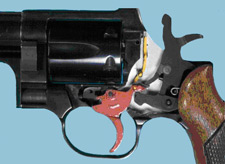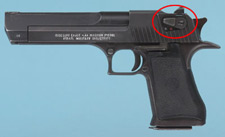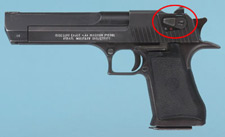Home | Glossary | Resources | Help | Contact Us | Course Map
Archival Notice
This is an archive page that is no longer being updated. It may contain outdated information and links may no longer function as originally intended.
Safety Features
General safety procedures should be followed when handling firearms in any environment. Other procedures are unique to the forensic firearms laboratory, including the laboratory firing range and bullet recovery facility.
The National Rifle Association (NRA) advocates three fundamental safety rules that must be applied simultaneously when handling a firearm:
- Always keep a firearm pointed in a safe direction.
- Always keep your finger off the trigger until ready to shoot.
- Always keep a firearm unloaded until ready to use.
In the laboratory
- be aware of all safety policies and procedures of the laboratory and their implementation,
- be responsible for your own safety and that of others in the working environment,
- handle every firearm as if it were loaded until it has been checked,
- follow the procedure for the particular laboratory regarding the receipt of loaded firearms.
See the YouTube Terms of Service and Google Privacy Policy
Revolvers
The results of the following steps in the examination of the safety features of revolvers should be documented:
- Confirm that the revolver is empty.
- Place a primed cartridge case into one of the cylinders.
- Rotate the chamber so that it aligns with the barrel when the hammer is fully cocked.
- Strike the trigger with enough force to release the hammer (but not so much force as to move the trigger all the way to the rear).
If the safety features are functioning, one of the following should occur (depending on the type of revolver):
- The hammer catches at the half-cock.
- The transfer bar drops away from the firing pin.
- The hammer block engages.
Properly functioning safety features should ensure that the hammer and/or firing pindo not make contact with the primer. This is determined by removing the cartridge case and observing if contact occurred.
- If there are no marks on the primer to indicate contact with the firing pin, the safety functioned properly.
- If there are marks on the primer, one or all of the safety features did not work properly.
If the primed case detonates, there are three possibilities:
- The safety is not functioning properly; retest the firearm.
- If the primed case detonates after retesting, improper function of the safety is confirmed.
- The test was not performed properly; retest the firearm.
- There is no safety feature present; examine the interior of the firearm to determine if a safety feature was present and subsequently removed.
| Note: |
|
In cases where it is alleged that the firearm discharged after being dropped, additional testing is required. Drop testing is discussed later in this module. |
Autoloading Pistols
Both semi- and full automatic pistols use the following steps in the examination of the safety features:
- Check for an external safety device; this should be clearly marked in most pistols.
- Confirm that the pistol is empty.
- Either pull the slide to the rear and release it forward to cock the firearm or manually cock the external hammer.
- Place the safety in the safe position.
- Pull the trigger.
If functioning properly, the safety should block the trigger from operating. If the safety is functioning improperly, the following test should be performed:
- Confirm that the pistol is empty.
- Place a primed cartridge case in the chamber.
- Pull the slide to the rear and release it forward to cock the firearm.
- Place the safety in the safe position.
- Pull the trigger.
Passive Safety Features
Most autoloading pistols have an internal passive safety feature called a disconnector. It ensures that the firearm is in battery before it can be fired and that a semiautomatic pistol does not fire in full automatic mode. This device disconnects the trigger from the firing mechanism until the firearm is in battery or until the trigger has been released and reset.
To test the disconnector, the results of the following steps should be documented (Note - for full automatic pistols, the selector switch should be in semiautomatic mode to conduct this test):
- Confirm that the pistol is empty.
- Pull the slide to the rear and release it forward to cock the firearm.
- Ensure that the external safety is disengaged.
- Pull the trigger and hold it to the rear while cocking the firearm by manipulating the slide.
(The firing mechanism should not be released; the trigger should move forward and reset.)
- Cock the firearm again.
- Disengage the external safety.
- Pull the slide to the rear far enough to take it out of battery.
- Pull the trigger.
The firearm should not fire. If the pistol fails either the external safety or the disconnector test, it may still function, but not as designed.
Some autoloading pistols have a magazine safety, which does not allow the firearm to fire when the magazine is disengaged. Typically the magazine safety is a device inside the magazine well that is depressed when the magazine is properly inserted, allowing the firearm to function normally.
If the magazine is removed, this device will normally engage the disconnector and keep the firearm from firing. If a submitted firearm has a magazine safety but no magazine, it will be necessary to obtain a magazine designed to be used in that firearm. If not available, improvise by inserting a screwdriver into the well and depressing the safety catch. The firearm will function, but not as designed.
Additional Online Courses
- What Every First Responding Officer Should Know About DNA Evidence
- Collecting DNA Evidence at Property Crime Scenes
- DNA – A Prosecutor’s Practice Notebook
- Crime Scene and DNA Basics
- Laboratory Safety Programs
- DNA Amplification
- Population Genetics and Statistics
- Non-STR DNA Markers: SNPs, Y-STRs, LCN and mtDNA
- Firearms Examiner Training
- Forensic DNA Education for Law Enforcement Decisionmakers
- What Every Investigator and Evidence Technician Should Know About DNA Evidence
- Principles of Forensic DNA for Officers of the Court
- Law 101: Legal Guide for the Forensic Expert
- Laboratory Orientation and Testing of Body Fluids and Tissues
- DNA Extraction and Quantitation
- STR Data Analysis and Interpretation
- Communication Skills, Report Writing, and Courtroom Testimony
- Español for Law Enforcement
- Amplified DNA Product Separation for Forensic Analysts





